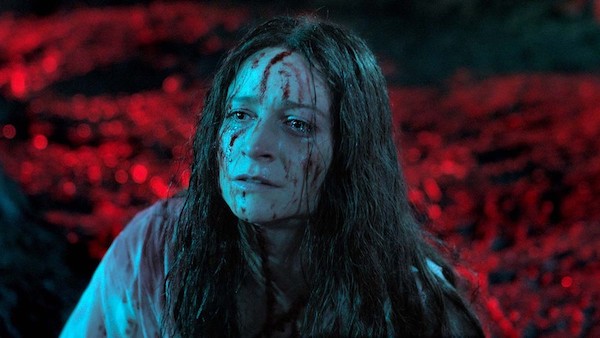Film Review: “Censor” — “The Horror, the Horror…”
By Ezra Haber Glenn
Censor explores thought-provoking questions about the strange relationships between films, society, fantasy, and reality — and individual identity — in an increasingly mediated and violent world.

Niamh Algar as Enid in a scene from Censor. Photo: Sundance Film Festival.
Enjoying its world premiere at the Sundance Film Festival this month, Prano Bailey-Bond’s Censor is just the sort of film that both filmmakers and critics love to discuss: it’s a movie about making and watching movies, giving us all an opportunity to reflect on this magical — and problematic — art form. (Or is it art at all — maybe it’s just a business…?). It’s also cast in a popular, but misunderstood, genre — horror, and of the particularly questionable, gory, and outright misogynistic “slasher” variety. But in this case the “psychological” qualifier should be included as well. To top it off, it’s the debut film from an emerging director who brings with her a deep knowledge of and appreciation for the history of film and some strong directorial chops put to excellent use. These elements are stirred together in a tight 84-minute package to explore thought-provoking questions about the strange relationships between films, society, fantasy, and reality — and individual identity — in an increasingly mediated and violent world.
The story takes place in the rosy — or perhaps it’s blood-red — nostalgia of ’80s Thatcherite England, a heyday for the appeal of high-tone social conservatism and low-budget gore-splattered films. Thanks to the widespread adoption of VCRs and video rental stores (which met a voracious hunger for ultra-violent offerings), movies with titles like “Cannibal Carnage” and “Don’t Go into the Church” are rapidly invading otherwise respectable homes and neighborhoods. The battle lines are being drawn over the future of these “nasty” films.
Enid Baines (Niamh Algar) works as a censor for an official review and ratings board, intent on safeguarding public morality by discerning — and holding — that extremely fine line separating “passable” levels of violence, sadism, misogyny, and general depravity from what is deemed “just too much.” She’s good at what she does and she believes deeply in the value of this work: censorship is essential for protecting the public. (A “consummate professional” is how I imagine the character is described in the casting notes.)
Algar conveys this strict clarity of purpose and unwavering diligence well, often wordlessly: it’s fascinating to watch her eyes in close-up as they flicker and dart to scrutinize every blurry VHS frame, to carefully catch, assess, and categorize each detail, recorded with clinical precision in her copious notes. As an added bonus, by watching Enid — and not the images of gratuitous violence she is exposed to — Bailey-Bond has cracked the fundamental conundrum that her film poses: how to examine the effects of exposure to these images of casual and callous violence without exploiting them.
Enid engages in reasoned conference-room debates and shop-talk with co-workers — discussions of eye-gouging and decapitation, mostly. And she spars with a sleazy and chipper purveyor of pulp, gore, and unapologetic depictions of murder, rape, and cannibalism (played by a well-cast and aptly named Michael Smiley, whose pores ooze an oily blend of the seductive, cheap, and menacing). Along the way, Censor deftly explores the interplay of censorship, free expression, public morality, violence, sexism, insanity, human nature, and even the line between truth and beauty in art. (One key insight worth pondering: the more absurd and over-the-top the gore is, the more obviously fantastical it must be — and thus, paradoxically, the more acceptable.)
Just outside the screening room where these conversations take place, of course, there’s an increasingly violent society, a world plagued by chaos, destruction, murder, and ethical free-fall. This is the ’80s, remember, when the serial killing craze — both the phenomenon and the public hysteria around it — was peaking; war and patriotism had been stripped of their veneers of honor; greed was good; the Church was exposed as inept, corrupt, and perverted to boot; punk was ascendant as the only truly moral movement. Clearly, no one was in charge but the free market. Against this bleak backdrop, Enid’s regulatory judgments take on either more or less importance, depending on appetite for paradox: are the censors upholding the last bulwark against the collapse of civilization? Or merely fiddling while Rome burns, a sop to those clutching their pearls over nasty pictures while in the streets the real horror is unfolding?
The drama unfolds as this pervasive societal violence begins to seep through the cracks in Enid’s calm professionalism. The newspapers report the emergence of an “Amnesiac Killer,” whose MO — at least on the face of it — seems to derive from the horrors depicted in a film she has recently approved. Is she to blame, or somehow connected? Closer to home, we learn that Enid is haunted by an incident from her own childhood, when she witnessed her sister’s violent abduction; years later she continues to struggle with the associated trauma, obsessing over her missing sibling like a phantom limb. As this past begins to reemerge, eerily, through echoes in the films she screens, it becomes impossible for her to maintain her distance and detachment from this unsettling subject.
Importantly, these exogenous factors provide only the context: the real tension is springing inside Enid’s troubled mind, which Algar plays subtly (at least at first), for maximum effect. As she struggles to maintain her sanity in an insane world, we see a woman tortured from within and without, unable to reconcile the social conflicts gnawing around here, traumatized by her own childhood and survivor’s guilt, subjected to a nonstop barrage of ultraviolent images.

Director Prano Bailey-Bond. Photo: Sundance Film Festival.
Thankfully, Bailey-Bond’s touchstone here is empathy, not prurient sadism. As we witness the effects of a toxic blend of images on Enid’s psyche as she confronts the world’s horror, we fear for her, but we feel for her as well. Most impressively, the director — one in a growing cohort of women directors intent on saving the horror genre from gratuitous sadism and its past gorification of misogyny — reminds us of what we should truly fear: the scariest thought imaginable is not to be the victim of a monster, but rather to become a monster oneself. (In this respect, Censor can actually be considered a direct descendant of a deeper horror tradition: tales of Dracula, the werewolf legend, and most pre–Walking Dead zombies were all terrifying not for what they might do to us, but for what they might make us do.)
On screen — in the clips Enid watches, as well as in her increasingly delusional perception of reality — Bailey-Bond lovingly renders the sights, sounds, and Fangoria aesthetic of ’80s VHS “macabre horror” as only a true aficionado could do: saturated red light, flickering screens, old-school aspect ratios, eerie synths, buckets of blood. It’s an impressive recreation. Stylistically, the film finds good company in the excellent production work found in Panos Cosmatos’s instant cult-classic from 2018, Mandy — but Censor pushes deeper, beyond simply imitating and celebrating an earlier era, probing further regions of moral ambiguity in both the genre and the plot.
A lot gets captured under a broad brush of “nostalgia” in films these days, not all of it worthwhile. Harmless, but overused, there’s the “homage” to great works or artistic movements; more lazy is its flip and trivializing cousin, the “cinematic reference,” little more than a shout-out to some previous classic, demoting appreciation to little more than a game of recognition: Look, it’s the camera angle from that classic shot in The Graduate! (Right, I get it — but why…?)
Alternatively, nostalgia can bleed too far into either satire or kitsch: restaging these periods provides us — the enlightened present — with an opportunity to poke fun at those unwoke/backwards/silly/misguided/evil people in the past. Satire is a vital tool in the arsenal of artistic and social critique, but the pressure for laughs can get in the way of a deeper, empathetic understanding of cinematic history.
On the third hand, even more troubling is the revisionist mode of nostalgia, which suffers from an overabundance of charity, a lack of skepticism, to the point of apologism and complicity: sanitizing the problems raised by the past will not make them go away. In fact, it only perpetuates the worst of bad ideas. (For more on the dangers of revisionist nostalgia in film, see over 100 years of criticism of The Birth of a Nation, from William Trotter to Spike Lee, with implications bleeding into the revisionist politics of blind allegiance to remaking a flawed American past.)
Thankfully, Bailey-Bond skillfully navigates these pitfalls and delivers a deeper, more mature, more thoughtful form of nostalgia. Neither uncritically celebrating nor unfairly caricaturing the violent and sexist tradition of slasher/horror movies, Censor delivers more than just a movie: it’s a film-essay. Just as, on a micro level, Enid must evaluate each scene with surgical precision to determine what to keep and what to cut in each movie, the director accepts this challenge at a meta level for a wonderful/horrible decade of film: if we could request a “do-over” of the ’80s, what would we preserve and what would we change? Only by carefully examining the various elements and aspects of this tradition — clinically, lovingly, and honestly — can we determine what to carry into the future of this genre. And we have to be honest enough to reject what would make us monsters ourselves
Afterword: If you enjoy Censor — Bailey-Bond’s first feature-length film — you might also check out her previous work, the short Nasty, which covers much of this same ground. Aspiring filmmakers in particular might benefit from seeing how a great director continues to work away at an idea, whittling and worrying the script, the characters, the framing, the visuals, until they get it just right. (And while we’re on the topic of tweaks to an already strong film: without spoiling too much, this particular reviewer would have rolled the credits five minutes earlier, when Enid is driving away from the climactic encounter. The aforementioned Mandy manages this uneasy “closing drive-off” extremely well. Unfortunately, Censor — not unlike Terry Gilliam’s Brazil and the studio cut of Blade Runner, both of which flirt with similar ambiguities — keeps rolling just a wee bit too long, spoiling some of the art in order to be sure we all “get it.”)
Ezra Haber Glenn is a Lecturer in MIT’s Department of Urban Studies & Planning, where he teaches a special subject on “The City in Film.” His essays, criticism, and reviews have been published in the the New York Observer, CityLab, the Journal of the American Planning Association, the Journal of Statistical Software, Experience Magazine, the Arts Fuse, and Next City, and he is the regular film reviewer for Planning magazine. Follow him on UrbanFilm and @UrbanFilmOrg.
